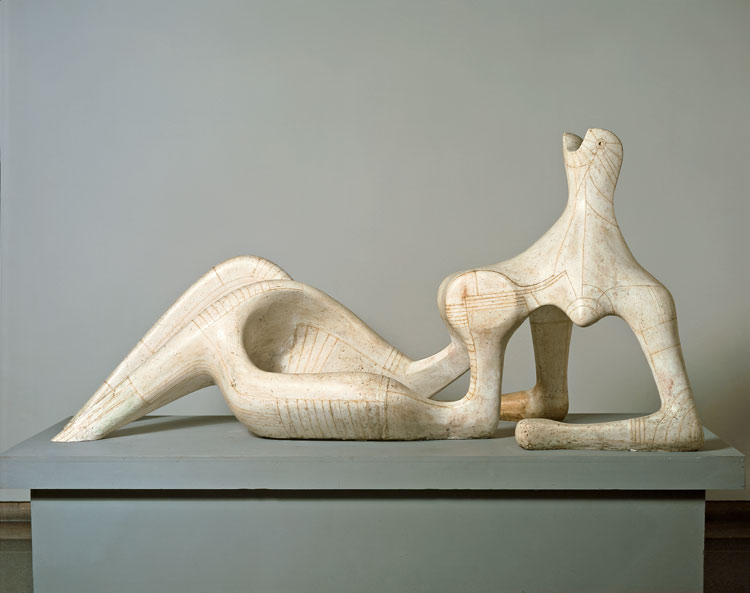Henry Moore: 1898 – 1986
 Recognized as the most important British sculptor of the 20th century, Henry Spencer Moore was born on July 30, 1898, in Castleford, Yorkshire. Moore had an early interest in sculpting however he began his career as a teacher in Castleford. After serving in the military during World War I, Moore studied at Leeds School of Art on an ex-serviceman’s grant. In 1921 he won a Royal Exhibition Scholarship to study sculpture at the Royal Academy of Art in London. Between 1924 – 1931 Moore was an Instructor of Sculpture at the Royal Academy. His first solo exhibition was held at the Warren Gallery, London, in 1928
Recognized as the most important British sculptor of the 20th century, Henry Spencer Moore was born on July 30, 1898, in Castleford, Yorkshire. Moore had an early interest in sculpting however he began his career as a teacher in Castleford. After serving in the military during World War I, Moore studied at Leeds School of Art on an ex-serviceman’s grant. In 1921 he won a Royal Exhibition Scholarship to study sculpture at the Royal Academy of Art in London. Between 1924 – 1931 Moore was an Instructor of Sculpture at the Royal Academy. His first solo exhibition was held at the Warren Gallery, London, in 1928
“Throughout his life Moore’s appetite for the history of world sculpture was insatiable. Drawings of sculptures in his early sketchbooks indicate that Palaeolithic fertility goddesses, Cycladic and early Greek art, Sumerian, Egyptian and Etruscan sculpture, African, Oceanic, Peruvian and Pre-Columbian sculpture particularly interested him. Moore believed passionately in direct carving and in ‘truth to materials’, respecting the inherent character of stone or wood. Almost all of his works from the 1920s and 1930s were carved sculptures, initially inspired by Pre-Columbian stone carving.” (MoMa)
Moore married Irina Radetsky in 1929. A student of painting at the Royal College, she would be Moore’s model for a series of life drawings over a six year period.
Moore’s sculpture of the 1930s was influenced by the work of Picasso, Hans Arp and Alberto Giacometti. “The subject-matter of Moore’s work of 1932–6 is, in some cases, no longer readily identifiable, although the human, psychological element informs even the seemingly abstract work of the 1930s.”
In the 1930s Moore was a member of Unit One, a group of artists lead by English landscape painter Paul Nash. From 1932 to 1939 he taught at the Chelsea School of Art. Moore was “an important force in the English Surrealist movement, although he was not entirely committed to its doctrines; Moore participated in the International Surrealist Exhibition at the New Burlington Galleries, London, in 1936.”
In 1940 Moore was appointed an official war artist and was commissioned by the War Artists Advisory Committee to execute drawings of life in underground bomb shelters. From 1940 to 1943 he focused almost entirely on drawing. His first retrospective took place at Temple Newsam, Leeds, in 1941 and he was given his first major retrospective in the United States by the Museum of Modern Art, New York, in 1946. Moore won the International Prize for Sculpture at the Venice Biennale of 1948.
Moore’s bronze Reclining Figure commissioned by the Arts Council for the Festival of Britain in 1951 was key in Moore’s development. “Previously the holes in his sculptures were dominated by the solid forms surrounding them but here ‘the space and the form are completely dependent on and inseparable from each other’ His work became less frontal and more completely three-dimensional. The reclining figure and the mother and child remained the dominant subjects of his sculpture.”
After the mid-1950s, many of Moore’s sculptures were made from natural objects including bones, shells, pebbles and flint stones.
Until the mid-1950s Moore made numerous preparatory drawings for his sculptures as well as pictorial studies of interiors and sculptures in landscape settings. He drew little between 1955 and 1970 but during the last 15 years of his life, he devoted more of his time to drawing for pleasure, independent of his sculpture. He first made prints in 1931, and he experimented with a process he called collograph. By the end of his life Moore had produced 719 prints.
“Moore executed several important public commissions in the 1950s, among them Reclining Figure, 1956–58, for the UNESCO Building in Paris. In 1963 the artist was awarded the British Order of Merit. In the 1970s there were many major exhibitions of Moore’s work, the finest being at Forte di Belvedere, overlooking Florence (1972). The Henry Moore Sculpture Centre in the Art Gallery of Ontario, Toronto, opened in 1974. It comprises the world’s largest public collection of Moore’s work, most of it donated by him between 1971 and 1974. In 1977 the Henry Moore Foundation was established at Much Hadham, and Moore presented 36 sculptures to the Tate Gallery in 1978.”
Henry Moore died in Much Hadham, Hertfordshire, on August 31, 1986.
Sources: Guggenheim, MoMA, Wikimedia Commons (images), Tate, Oval With Points Photo by Maia C
SOURCE: Daily Art Fixx - Art Blog: Modern Art, Art History, Painting, Illustration, Photography, Sculpture - Read entire story here.
Read More



















